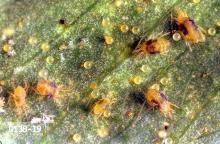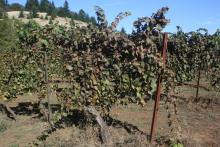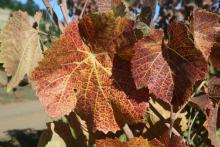McDaniel spider mite (Tetranychus mcdaneli)
Two-spotted spider mite (Tetranychus urticae)
Willamette spider mite (Eotetranychus willametei)
Yellow spider mite (Eotetranychus carpini borealis)
Pest description and crop damage Adults are about 0.02 inch in length. They have eight legs and an oval body. Female two-spotted spider mites have large dark blotches on each side of the body. McDaniel spider mites have conspicuous white spines. Yellow spider mites are smaller, pale yellow, and usually have small black dots along the sides of the body. In Washington vineyards, McDaniel spider mites are often predominant. Yellow spider mites rarely are seen on Washington grapes but may be found in Oregon. The Willamette spider mite has been a problem in some vineyards in Oregon's Willamette Valley, particularly in warm, dry seasons.
Eggs are spherical and translucent white. Newly hatched larvae are six-legged and go through two nymphal stages before reaching adulthood.
Spider mites damage grape leaves by puncturing cells and sucking out the contents. This produces small yellow-white spots on the upper leaf surface. In heavy infestations, the spots coalesce and the leaf turns yellow or red (in red cultivars). In general, spider mites are not consistently a major problem on Pacific Northwest grapes. However, when a problem occurs, it invariably can be traced to use of broad-spectrum insecticides, overuse of sulfur in spray programs, or environmental conditions conducive to mite outbreaks (e.g., hot, dry, and dusty conditions).
Biology and life history Spider mites overwinter as fertilized females under bark or in soil debris. They move to young foliage when buds break in spring and produce many generations from spring to autumn. Females can lay up to 10 eggs per day and more than 200 during their lifetime. Egg-to-adult development can take 7 to 10 days during summer. They thrive under hot, dry conditions. Large colonies of mites produce webbing. Dispersal occurs mainly through wind transport.
Sampling and thresholds Thresholds have not been established for Pacific Northwest vineyards, but economic damage is unlikely at levels below 15 to 20 per leaf. Treatment thresholds must always consider the presence of predatory mites, which are major biological control agents (see below).
Management-biological control
An extensive community of natural enemies successfully regulates spider mite populations when undisturbed by pesticides. Consequently, spider mite problems on grapes and many other crops are considered secondary pest problems resulting from the elimination or suppression of natural enemies. Spider mites are not often a problem in low chemical input vineyards or with the use of "soft chemicals." However, sulfur, which is often considered a "soft chemistry," can cause mite outbreaks when used extensively as in the case with organic vineyards.
Research at WSU is investigating the components and interactions of the natural enemy community affecting spider mites in Pacific Northwest vineyards so that it can be managed more effectively. Results show that multiple applications of sulfur for disease management (more than five per season) tend to increase incidence and severity of spider mite problems by inhibiting the function of predators, particularly predatory mites (Phytoseiidae). Many Oregon vineyards use multiple sulfur applications for powdery mildew management. However, spider mites are not often a problem for western Oregon vineyards, but problems have arisen in dry years and under dusty conditions.
Management-cultural control
Spider mite outbreaks frequently occur in arid regions and in non-arid regions where vines are exposed to dusty conditions and/or water-stressed. Using vineyard floor management techniques that control dust (e.g., reduced tillage or cover cropping) along vineyard access roads and headlands has reduced mite problem areas in vineyards. Where competition and low soil moisture is a concern, there are short, shallow-rooted grasses that are able to be used as a non-competitive cover crop (e.g., bulbous bluegrass, sheep fescue, "Elf" perennial ryegrass, etc.). Excessive use of sulfur or use of certain pesticides (see notes therein) can precipitate spider mite outbreaks.
For more information see EB2010 Cover Crops as a Floor Management Strategy for Pacific Northwest Vineyards, WSU Extension (https://pubs.extension.wsu.edu/cover-crops-as-a-floor-management-strategy-for-pacific-northwest-vineyards).
Management-chemical control: HOME USE
- bifenthrin
- horticultural oils (rates vary with product)-Ensure good coverage. Some formulations OMRI-listed for organic use.
- insecticidal soap-Complete coverage, especially of the underside of leaves, is essential.
- malathion
- neem oil-Some formulations are OMRI-listed for organic use.
- plant essential oils (cinnamon, clove, peppermint, rosemary, and thyme)-Some formulations are OMRI-listed for organic use.
- pyrethrins (often as a mix with other active ingredients)-Some formulations are OMRI-listed for organic use.
- spinosad-Some formulations are OMRI-listed for organic use.
- sulfur-Don't use when temperatures exceed 90°F to avoid plant damage.
- zeta-cypermethrin
Management-chemical control: COMMERCIAL USE
- abamectin (Agri-Mek SC and other brands) at 0.00957 to 0.019 lb ai/A. Apply with a nonionic surfactant (NIS) for contact knockdown only. Do not exceed two applications or 0.019 lb ai/A per season. Harmful to predatory mites. Group 6 insecticide. Restricted use pesticide.
- bifenazate (Acramite 50WS) at 0.375 to 0.50 lb ai/A. PHI 14 days. Use at least 50 gal water/A. Do not use more than once per season. Group 20 pesticide.
- cyflumetofen (Nealta) at 0.179 lb ai/A. PHI 14 days. Apply at the first sign of mites. Controls all life stages from egg to adult. Do not use more than 2 applications/season (maximum use is 0.36 lb ai/A per year). Do not make sequential applications. Apply with a minimum of 50 gal water/Acre to ensure proper coverage of the vine to control all life stages present. Sprays are compatible with beneficial insects. Group 25A pesticide.
- fenbutatin-oxide (Vendex 50WP) at 0.5 to 1.25 lb ai/A. PHI 28 days. Do not use more than twice per season or apply more than once in 21 days. Do not use more than 2 lb ai/A per year, and do not use more than 250 gal/A water. Group 12B acaricide. Restricted use pesticide.
- hexythiazox (Onager) at 0.094 to 0.188 lb ai/A. PHI 7 days. Do not apply more than once per season, and do not exceed 0.188 lb ai/A per season. Controls eggs and immatures. Group 10A acaricide.
- insecticidal soap (M-Pede and other brands) at 1-2% solution; Consult label for rates. PHI 0 days. Do not mix with sulfur. Some formulations are OMRI-listed for organic use.
- pyridaben (Nexter and other brands) at 0.21 to 0.5 lb ai/A. PHI 7 days. Apply in 50 to 400 gal/A water. Use the higher rate to ensure adequate concentrations in mature vineyards with dense foliage. Do not apply more than twice a season or more than 0.5 lb ai/A per year. Harmful to predatory mites. Group 21A acaricide.
- spirodiclofen (Envidor 2 SC) at 0.25 to 0.53 lb ai/A. PHI 14 days. Use at least 50 gal/A water application. Do not use more than once a season, and do not exceed 0.53 lb ai/A per season. Group 23 acaricide.






